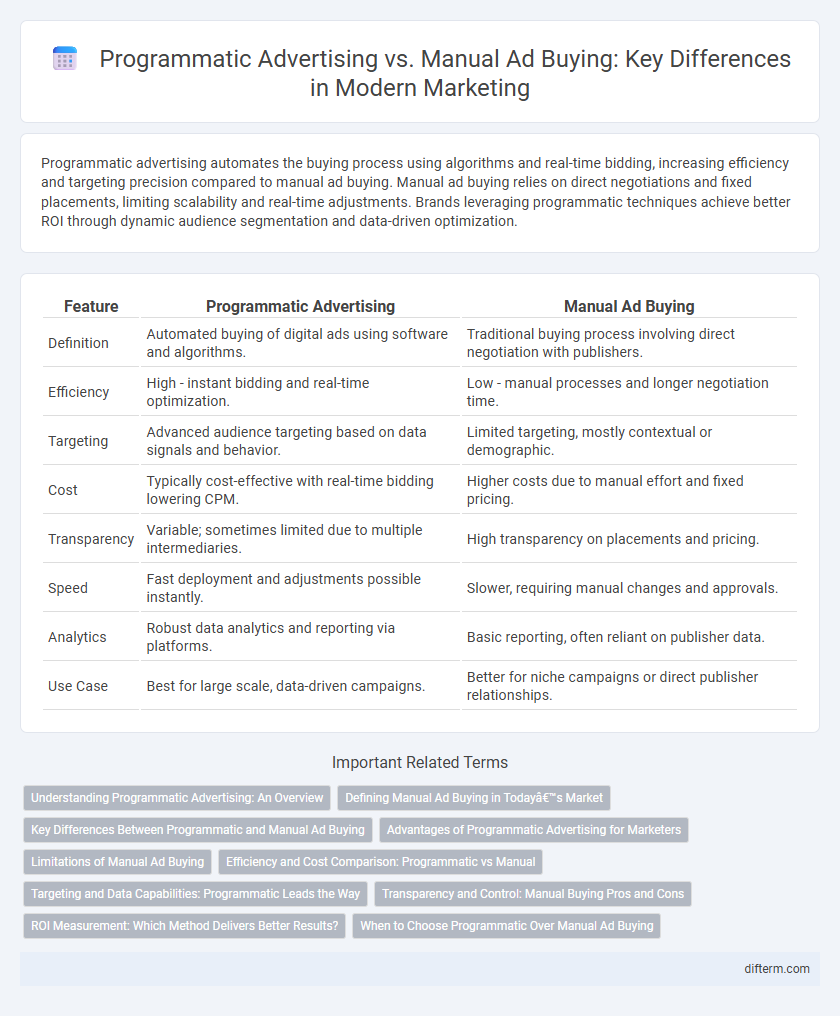Programmatic advertising automates the buying process using algorithms and real-time bidding, increasing efficiency and targeting precision compared to manual ad buying. Manual ad buying relies on direct negotiations and fixed placements, limiting scalability and real-time adjustments. Brands leveraging programmatic techniques achieve better ROI through dynamic audience segmentation and data-driven optimization.
Table of Comparison
| Feature | Programmatic Advertising | Manual Ad Buying |
|---|---|---|
| Definition | Automated buying of digital ads using software and algorithms. | Traditional buying process involving direct negotiation with publishers. |
| Efficiency | High - instant bidding and real-time optimization. | Low - manual processes and longer negotiation time. |
| Targeting | Advanced audience targeting based on data signals and behavior. | Limited targeting, mostly contextual or demographic. |
| Cost | Typically cost-effective with real-time bidding lowering CPM. | Higher costs due to manual effort and fixed pricing. |
| Transparency | Variable; sometimes limited due to multiple intermediaries. | High transparency on placements and pricing. |
| Speed | Fast deployment and adjustments possible instantly. | Slower, requiring manual changes and approvals. |
| Analytics | Robust data analytics and reporting via platforms. | Basic reporting, often reliant on publisher data. |
| Use Case | Best for large scale, data-driven campaigns. | Better for niche campaigns or direct publisher relationships. |
Understanding Programmatic Advertising: An Overview
Programmatic advertising utilizes automated technology and algorithms to buy and optimize digital ad placements in real time, enhancing targeting precision and efficiency compared to manual ad buying. It leverages data insights, including user behavior and demographics, to deliver personalized ads across multiple platforms, reducing human error and saving time. In contrast, manual ad buying relies on direct negotiations and manual insertion orders, often resulting in slower execution and less dynamic campaign management.
Defining Manual Ad Buying in Today’s Market
Manual ad buying in today's market involves advertisers directly negotiating and purchasing ad inventory without automated systems, allowing for personalized control but limiting scalability and efficiency. It requires more time and resources to manage campaigns, often resulting in slower response to market changes compared to programmatic advertising. Despite technological advancements, manual buying remains relevant for niche markets and premium placements where human judgment is crucial.
Key Differences Between Programmatic and Manual Ad Buying
Programmatic advertising automates the buying and placement of ads using AI and real-time bidding, increasing efficiency and targeting precision, whereas manual ad buying relies on direct human negotiation and placement with publishers. Programmatic platforms utilize vast data sets and algorithms to optimize ad spend dynamically, contrasting with the static, often time-consuming process of manual ad buying. Key differences include scalability, speed of execution, data-driven targeting, and cost-effectiveness, with programmatic offering greater flexibility and real-time adjustments.
Advantages of Programmatic Advertising for Marketers
Programmatic advertising enables marketers to achieve precise audience targeting through real-time data analysis, increasing campaign efficiency and return on investment. Automated bid management reduces human error and operational costs, while dynamic optimization ensures ad placements reach the most relevant users at optimal times. This technology-driven approach offers scalability and enhanced measurement capabilities, empowering marketers to make data-driven decisions and improve overall ad performance.
Limitations of Manual Ad Buying
Manual ad buying often suffers from limited scalability and slower response times compared to programmatic advertising, restricting marketers' ability to optimize campaigns efficiently. The reliance on human negotiation and manual insertion orders increases the risk of errors and reduces the flexibility to adjust bids or targeting in real-time. This process also incurs higher operational costs and lacks the advanced data-driven targeting capabilities that programmatic systems provide.
Efficiency and Cost Comparison: Programmatic vs Manual
Programmatic advertising leverages automated technology to optimize ad placements in real-time, resulting in higher efficiency and reduced labor costs compared to manual ad buying. Manual ad buying requires extensive human intervention and negotiation, often leading to slower campaign deployment and higher operational expenses. Studies show that programmatic campaigns typically achieve 20-30% better cost-efficiency while maximizing ROI through precise targeting and dynamic budget allocation.
Targeting and Data Capabilities: Programmatic Leads the Way
Programmatic advertising leverages advanced algorithms and real-time data to deliver hyper-targeted ads to specific audience segments, surpassing the precision of manual ad buying methods. Its ability to analyze vast datasets, including user behavior, demographics, and contextual signals, enables dynamic optimization for maximum campaign effectiveness. This data-driven approach enhances targeting accuracy, reduces wasted impressions, and significantly improves return on ad spend compared to traditional manual strategies.
Transparency and Control: Manual Buying Pros and Cons
Manual ad buying offers enhanced transparency as marketers directly negotiate placements and understand inventory sources, fostering clear budget allocation. Control over targeting and creative executions remains precise, allowing tailored adjustments based on campaign goals. However, this process can be time-consuming and less scalable compared to automated systems, potentially limiting real-time optimization opportunities.
ROI Measurement: Which Method Delivers Better Results?
Programmatic advertising leverages real-time data and automated algorithms to optimize ad placements, driving higher ROI through precise targeting and efficient budget allocation. Manual ad buying often lacks the scalability and data integration necessary for dynamic optimization, resulting in less accurate ROI measurement. Studies show programmatic campaigns can improve conversion rates by up to 30%, highlighting superior performance in measuring and maximizing return on investment.
When to Choose Programmatic Over Manual Ad Buying
Programmatic advertising is ideal when targeting specific audience segments with data-driven precision and real-time optimization, ensuring higher efficiency and scalability. Manual ad buying suits campaigns requiring direct publisher relationships, customized negotiation, and control over inventory quality. Choose programmatic for dynamic, performance-focused marketing that benefits from automation and large-scale data insights.
programmatic advertising vs manual ad buying Infographic

 difterm.com
difterm.com